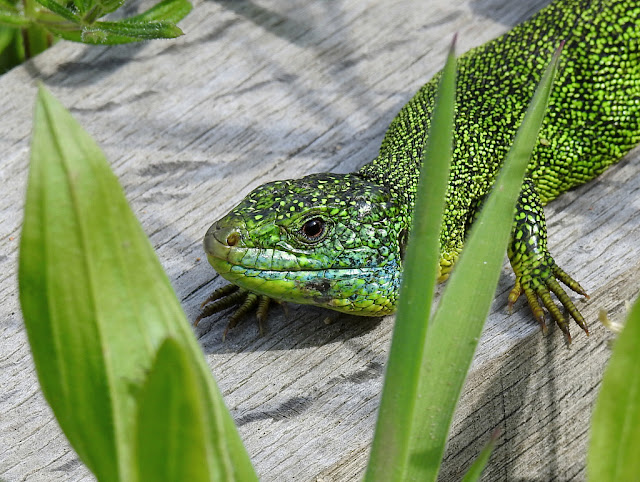It is hard to argue with good data. Exactly what that data means might be up for discussion, but numbers alone can usually tell you something at least. For example, Barn Owl has been a regular feature of my nocmig activities here in sunny Bridport. I didn't keep accurate records in 2020 (my first year) but Barn Owl featured 'often', let's say. However, I do know that the species occured 125 times in 2021 and 81 times in 2022. This year I have been recording at a similar effort level, and have thus far tallied ZERO Barn Owls.
I don't know what that data means exactly, but I do not sense a success story.
Two weeks on Jersey in the latter half of May would not have been my choice of holiday, but it was a family affair, not a birding trip. We were based in the north east of the island, and I did manage to squeeze in a fair bit of local birding by just walking from our cottage. But honestly, I have never been more disappointed. It was dire. There were strikingly few birds, especially away from the coast. Worse still, it was a struggle to find insects, and looking for them became a bit of a thing. Scanning hedgerows, clumps of umbellifers; bashing bushes to see what might be dislodged; anything to try and stir up some life. The farmland was decorated with loads of nice-looking hedges, mature trees, lush verges...but depressingly few creepy-crawlies. Was the cold, late spring responsible? Or something more sinister?
A visit to the west side of the island, including the wetland reserve at St Ouen's Pond, was better...

|
|
Marsh Harriers were a constant presence. Always nice. |

|
|
Loose-flowered Orchid was an unexpected plant tick |

|
|
A couple of pink ones |
Main highlight of the jaunt out west was a splendid reptile tick...

|
|
Western Green Lizard, a surprisingly hefty beast. |
Prior to the trip I had done no research re the Channel Islands Nat Hist, and to my shame had been unaware even that Short-toed Treecreepers live there (didn't see any!) so the orchid and lizard ticks were a nice bonus. Neither made up for the lack of life elsewhere though...

|
|
Very lush, but pathetically few insects... |

|
|
Spent a few minutes scanning this pretty meadow. A couple of bees and a
hoverfly sp was about it... |
St Catherine's Wood was a short walk away, and four visits in search of
Short-toed Treecreeper and Red Squirrel produced neither, but I
did see a Firecrest...

|
|
Firecrest in St Catherine's Wood, Jersey. |
All the above opinions about dearth and direness are based on no data at all,
just a gut feeling. I have no numbers, and therefore no real evidence. All I
can say is that I will never choose Jersey for a birding holiday!
A Black-headed Wagtail was discovered at St Ouen's Pond shortly after
our visit to it, and it struck me that this little oasis of life, with its
plentiful insects, breeding Lapwings and flashy flava, would give a very misleading impression of Jersey birding if it was the
only place you visited. It made me wonder if a similarly distorted view of the
state of our countryside might be possible if you only go to the 'good'
bits?
There are a lot of 'good' bits where I live, and I continue to stumble across unexpected surprises from time to time. A couple of days ago I wandered up the river valley from home, as I have many times before. A recently-cut field (silage?) had been deliberately left unshorn on one side. The reason? These, I guess...

|
|
Hundreds and hundreds of orchids - Southern Marsh I
think... |

|
|
...including some whoppers. |
I had no idea this beautiful display of orchids was on my doorstep. Of course, such delights do make you wonder just what the countryside would be like if less of it was in such a dreadful state...
My Twitter feed is a depressing litany of ecological vandalism, declining
populations of this and that, and so on. Lovely - albeit insignificant -
discoveries like the one above do cheer me up a bit, but there is no doubt in
my mind where it's all headed, data or not...

Gav, only those of us with fifty years of observation can really notice such declines. Still, we persist. Gems of hope do appear here and there, such as the recent discovery of Black-Veined White butterflies.
ReplyDeleteSadly the Black-veined Whites are a red herring, Ric. Not real. Released, not wild.
DeleteThere are many birders with 50 year-old notebooks full of what are now unimaginable counts of once everyday birds. That's reality.
I agree that the BV Whites must have been released just like the Purple Emperors my son saw in my garden - whilst I was away. There's a lot of home breeding going on and they may just help increase the numbers once common species such as Small Tortoiseshell and Red Admiral - very low numbers this year.
DeleteAnecdotally, my car windscreen has far more insects on it this year than the previous three or four. Maybe it's not all bad news?
There are several conservation projects ongoing local to me, and it is heartening to visit areas that are buzzing with life, but they always feel to me like isolated pockets of wealth in an impoverished land. It is hard to stay optimistic.
DeleteI often wish I didnt know what I know. If only I could walk around in a blissful state of ignorance...
ReplyDeleteKnow what you mean... 😐
Delete